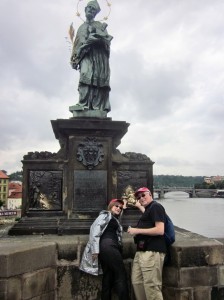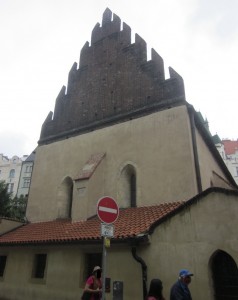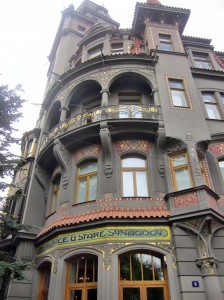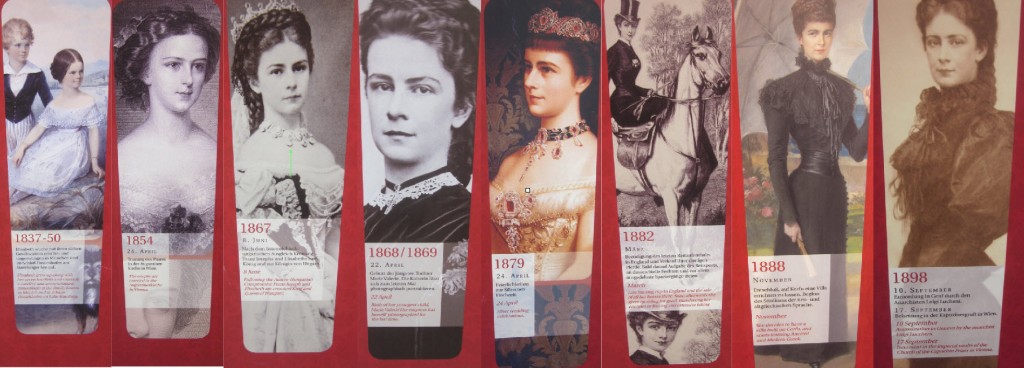Tag Archive
activity architecture art artist building Canada children city CostSaver downtown drive i-95 entertainment Europe event exhibit family festival Florida food fun historic History landmark local Museum music Nature New Zealand Ontario roadtrip sculpture Seattle show sights sightseeing tour tourist Trafalgar travel travelblogger view Washington Washington State water world
Cosmos Tour: Prague, Vienna Budapest – Red Bull from Austria
In 1976 in Thailand, Chaleo Yoovidhya introduced a drink called Krating Daeng whose main ingredient is taurine. Austrian Dietrich Mateschitz visited Thailand in 1982 and noticed that the drink cured his jet lag. In 1984, Mateschitz co-founded Red Bull GmbH with Yoovidhya, modifying the ingredients to suit Western tastes, and launched it in Austria in 1987. Red Bull is the highest selling energy drink in the world.
Cosmos Tour: Prague Vienna Budapest – Prague Astronomical Clock
Walking through the streets of Prague, you will come across the Astronomical Clock. Each hour, the wooden figures of apostles appear in the windows and some of the sculptures move. When the apostles finish their story, the golden rooster crows and shakes its wings, the bell rings and the clock chimes the hour.
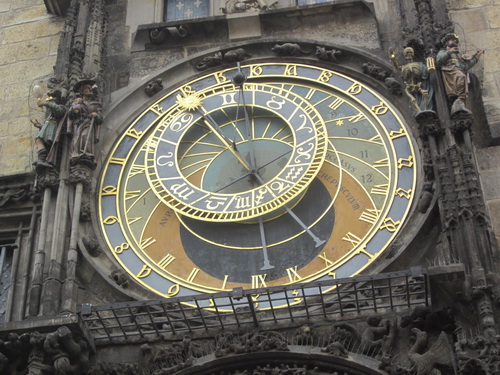
An urban myth which went on for centuries was that when the Prague Councillors found out that the 15th century clock maker Hanus (Jan of Ruze) was going to make another clock, they became jealous and blinded him. However in 1961, the real artist was discovered in an old document which described the astronomical dial and says it was made by Mikulas of Kadan in 1410.
Cosmos Tour: Prague Vienna Budapest – Halushka dumplings and Cimbalon
On the Cosmos Tour to Prague, Vienna and Budapest, the first optional excursion was a typical Slavic evening in the well-known U Marčanů restaurant, and included folk music with Bohemian, Moravian and Slovakian singing and dancing, plus gypsy music and dancing. The performers were fabulous at getting the audience involved, and great fun ensued. A musical instrument called a cimbalon was played; it’s a large, trapezoidal box with metal strings stretched across, and is played by striking two hammers against the strings.
Here’s a short video of the cimbalon in action:
The 3-course meal accompanied by unlimited drinks (wine/ beer/soft drinks) started with my favorite food of the whole trip – halushka , little dumpling bits topped with cheese and fried bacon (probably called bryndza) which is one of the the Slovak national dishes. Now we know why. The main course was pork on a skewer with delicate Lyonnaise potatoes, green beans and roasted potatoes.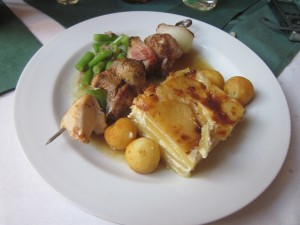
Everyone ate and laughed and enjoyed the evening.
Cosmos Tour: Prague Vienna Budapest – Charles Bridge Prague
The Charles Bridge over the river Vltava is the oldest bridge in the city, built between the 14th and 15th century and lined with statues and lamps and with Gothic towers on both ends.
The bronze statue of St. John of Nepomuk is the oldest (and most famous) one, created in 1683. St. John was a parson who refused to betray a secret confided to him by Queen Sophia when asked by King Wenceslas IV. In 1393, he was tortured on the king´s demand and then thrown into the river from the Charles Bridge. After his death, supposedly five stars appeared above the river.
There is a brassy cross with five stars at the place on the parapet, where he was thrown to the river. If you place your hand on the cross, so that each finger will touch one star, you can wish for something and it will be fulfilled. People also touch the relief on the statue for luck.
Cosmos Tour: Prague Vienna Budapest – Prague Jewish Ghetto
The former Jewish Ghetto (now called Josefov) in Prague goes back to the 12th century. In fact, the oldest synagogue in Europe, the Old-New Synagogue, is still there and it is still used for its purpose, as there are regular services. An old legend says it was built of stones from the Second Temple in Jerusalem. This quarter was demolished in 1897. Today, there are 6 synagogues, the Jewish City Hall and the Old Jewish Cemetery from the 15th century. Notice the Rabbi’s house has gold decorations and the clock with hebrew letters which dates to 1674.
In 1389 the biggest anti-Jewish pogrom in the Middle Ages took place here, when about 3,000 citizens of the Jewish Quarter were killed, turning the walls of the Old–New Synagogue dark with blood. Their homes were plundered and burned.
However, in the 16th century, this quarter was thriving. Some of the synagogues we can still see were built then. The Maisel Synagogue houses an exhibition of the Jewish Museum in Prague. In the 1950’s, the Pinkas Synagogue became a Memorial to victims of the Holocaust. The walls of the nave, gallery and vestibule were covered with names of about 80,000 Bohemian and Moravian Jews. You can also see drawings of Jewish children made in the Terezin concentration camp between 1942 and 1944. There were more than 10,000 children under the age of 15 there. In 1577, the High Synagogue was built as a part of the Jewish City Hall, and the original vault with some Gothic features and stucco decoration still can be seen.
Nowadays, Paris St. in this area is one of the most popular places to live in Prague. If you get hungry, you can eat at the King Solomon kosher restaurant. Michelle Obama ate there when she was in town.
www.cosmos.com/Product.aspx?trip=46050
Cosmos Tour: Prague Vienna Budapest – Free Higher Education
If you study in Czech in the Czech Republic, there are no tuition fees at public higher education institutions. If you learn in another language, fees vary depending on the language of instruction or the courses.
www.cosmos.com/Product.aspx?trip=46050
Cosmos Tour: Prague Vienna Budapest – Prague Underground Tunnels
Prague is the only capital city which has 90 km of underground tunnels (called kolektory) in a huge network including gas and steam pipes, water mains, to a pneumatic postal service, high and low voltage cables, telecommunications cables and also special networks connecting individual companies. Some are 30-40 meters underground, and a special train runs on five-km routes transporting pipes, metal parts and other components here and there.
You can tour them.
Cosmos Tour: Prague Vienna Budapest – Danube River
The Cosmos Tour through Prague, Vienna and Budapest criss-crosses the Danube River. The river flows from the Black Forest to the Black Sea for 2,872 km, and passes through or touches the borders of 10 countries: Romania, Hungary, Serbia, Austria, Germany, Bulgaria, Slovakia, Croatia, Ukraine, and Moldova.
Cosmos: Prague Vienna Budapest – Smart Car Beginnings, Swatchmobile
In Europe the Smart Car is thought of as a vehicle that fits 2 persons and a case of beer.
The Smart car idea started with Nicolas Hayek, the SMH CEO of the Swatch watch company. He saw the potential for an “ultra-urban” car, a small and stylish city car; it became known as the “Swatchmobile“.
First there was some backing by Volkswagon, but the first model was produced by Daimler-Benz (Mercedes) in October 1998, calling the original model “Fortwo” – love that name!
www.cosmos.com/Product.aspx?trip=46050
Cosmos Tour: Prague Vienna Budapest – Beloved Sisi, Empress Elisabeth
Just as we have our beloved famous Disney princesses, the Austro-Hungarian Empire had theirs – but she was for real. They call her by her nickname Sisi, and she was their Empress for 44 years.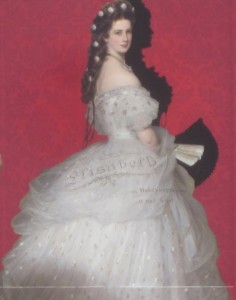
Their have been numerous movies, plays, operas, ballets, books and music about her in the German speaking world. It is probably the trilogy of romantic films about her life which starred a young Romy Schneider which made her a household name. She is so popular that the 3 movies are shown every Christmas on Austrian, German, Dutch, and French television.
Though her husband Emperor Franz Josef adored her, she felt stifled by Habsburg court life and traveled extensively whenever and wherever she could. She loved learning and spoke English, French, modern Greek and Hungarian. Her domineering mother-in-law made her life miserable and even took away her children to raise. Her first daughter died as a toddler and her beloved son Crown Prince Rudolph, heir to the throne, committed suicide along with his lover, and she never fully recovered from that loss.
Empress Elisabeth was vain and did not sit for any portraits after she was 32 and would not allow any more photographs, so that her public image would always remain of her youthful self. She was tall, and compulsively maintained the same low weight all through her life thru exercise (horsemanship, fencing, hiking) and fasting.
Her interest in politics had developed as she matured. She felt an intense emotional alliance with Hungary, and worked toward it gaining an equal footing with Austria. Elisabeth was an ideal mediator between the Magyars and the Emperor. She was a personal advocate for Hungarian Count Gyula Andrássy (he was a lifelong friend, and possibly her lover).
Finally, the Austro-Hungarian Compromise of 1867 created the double monarchy of Austro–Hungary. Andrássy was made the first Hungarian prime minister, and in return he saw that Franz Josef and Elisabeth were officially crowned King and Queen of Hungary.
Sisi was assassinated “by accident” in 1898 by Luigi Lucheni, who had planned to kill the Duke of Orleans, Pretender to France’s throne, but the Duke had left town. Despite warnings of possible assassination attempts Elisabeth, now age 60, traveled incognito to Geneva. She eschewed the protection which the Swiss government had offered and only promenaded with her lady-in-waiting.
You can visit many of her residences: her apartments in the Hofburg and the Schönbrunn Palaces in Vienna, the imperial villa in Ischl, the Achilleion in Corfu, and her summer residence in Gödöllő, Hungary.
These plaques, mounted in Vienna, tell some of her story:
